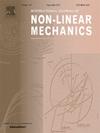具有模态耦合不稳定性和其中一个接触界面负刚度的非线性模型的有界响应
IF 3.2
3区 工程技术
Q2 MECHANICS
International Journal of Non-Linear Mechanics
Pub Date : 2025-09-08
DOI:10.1016/j.ijnonlinmec.2025.105237
引用次数: 0
摘要
模态耦合是一种摩擦诱发振动的机制,被认为是研究制动尖叫最相关的理论之一。这项工作从一个具有两个自由度(DOF)且没有外部阻尼源的非线性模型中引入了一个接触界面的负刚度效应。线性化版本呈现多重稳定性,在特定参数组合下,两点出现纯虚特征根(即边缘或中性稳定条件)。此外,在这些情况下,除非应用精确的参数组合,否则会出现不相称的固有频率比。因此,使用谐波平衡法(HBM)开发了一个近似的双频解,以评估哪些频率对接触界面上交换的功率起主要作用。主要结果表明,在某些边缘稳定条件下,系统产生了准周期振荡,其中液体功率的交换(即由于系统本身的振荡)由主导频率组合的重要贡献来表示。结果,交换的总功作为有界脉冲序列随时间变化。本文章由计算机程序翻译,如有差异,请以英文原文为准。
Bounded responses from a nonlinear model with mode-coupling instability and negative stiffness in one of its contact interfaces
Mode coupling is a mechanism of friction-induced vibration that is considered one of the most relevant theories for studying brake squeal. This work introduced a negative stiffness effect in one of the contact interfaces from a nonlinear model with two degrees-of-freedom (DOF) and no external sources of damping. The linearized version presented multi-stability, where pure imaginary characteristic roots (i.e., marginal or neutral stability conditions) occurred for two points under specific parameter combinations. Besides, incommensurate natural frequency ratios prevail under those circumstances unless the exact parameter combinations are applied. Thus, an approximated two-frequency solution was developed using the Harmonic Balance Method (HBM) to evaluate which frequencies played the main role on the power exchanged at contact interfaces. The main results show that some of the marginally stable conditions produced quasi-periodic oscillations, where the liquid power exchanged (i.e. due to the oscillation of the system alone) was represented with important contributions of dominant frequency combinations. As a result, the total work exchanged varied in time as a bounded train of pulses.
求助全文
通过发布文献求助,成功后即可免费获取论文全文。
去求助
来源期刊
CiteScore
5.50
自引率
9.40%
发文量
192
审稿时长
67 days
期刊介绍:
The International Journal of Non-Linear Mechanics provides a specific medium for dissemination of high-quality research results in the various areas of theoretical, applied, and experimental mechanics of solids, fluids, structures, and systems where the phenomena are inherently non-linear.
The journal brings together original results in non-linear problems in elasticity, plasticity, dynamics, vibrations, wave-propagation, rheology, fluid-structure interaction systems, stability, biomechanics, micro- and nano-structures, materials, metamaterials, and in other diverse areas.
Papers may be analytical, computational or experimental in nature. Treatments of non-linear differential equations wherein solutions and properties of solutions are emphasized but physical aspects are not adequately relevant, will not be considered for possible publication. Both deterministic and stochastic approaches are fostered. Contributions pertaining to both established and emerging fields are encouraged.

 求助内容:
求助内容: 应助结果提醒方式:
应助结果提醒方式:


